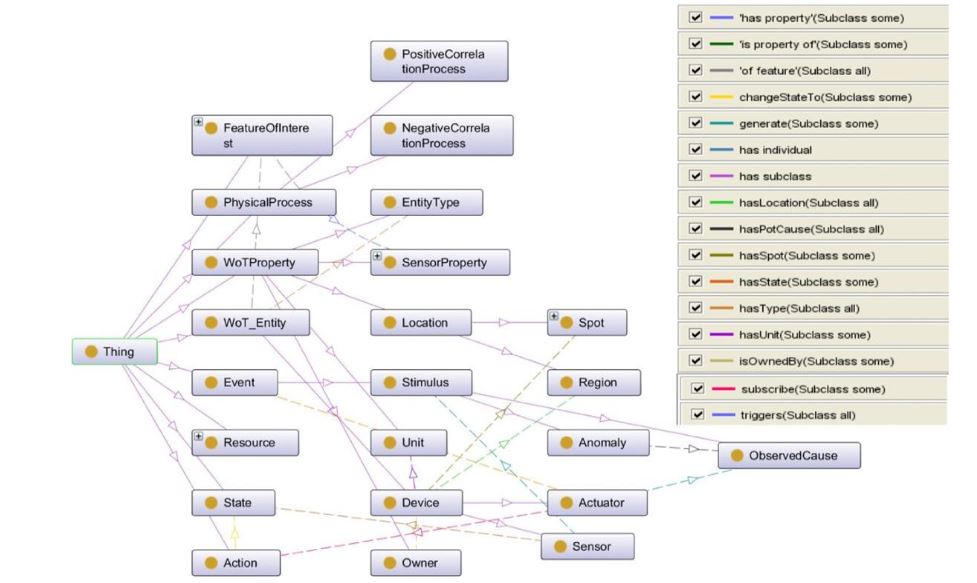ABSTRACT
Web of Things (WoT) facilitates the discovery and inter-operability of Internet of Things (IoT) devices in a cyber-physical system (CPS). Moreover, a uniform knowledge representation of physical resources is quite necessary for further composition, collaboration, and decision-making process in CPS. Though several efforts have integrated semantics with WoT, such as knowledge engineering methods based on semantic sensor networks (SSN), it still could not represent the complex relationships between devices when dynamic composition and collaboration occur, and it totally depends on manual construction of a knowledge base with low scalability.
In this paper, to addresses these limitations, we propose the semantic Web of Things (SWoT) framework for CPS (SWoT4CPS). SWoT4CPS provides a hybrid solution with both ontological engineering methods by extending SSN and machine learning methods based on an entity linking (EL) model. To testify to the feasibility and performance, we demonstrate the framework by implementing a temperature anomaly diagnosis and automatic control use case in a building automation system. Evaluation results on the EL method show that linking domain knowledge to DBpedia has a relative high accuracy and the time complexity is at a tolerant level. Advantages and disadvantages of SWoT4CPS with future work are also discussed.
RELATED WORK
In this section we provide an overview of related work on leveraging semantic technology to annotate sensor data. We summarize the methods into two main categories: (1) top-down methodology based on linked data and ontological knowledge engineering; and (2) bottom-up methodology based on machine learning models by extracting knowledge from existing data sources.
PROBLEM STATEMENT AND REQUIREMENTS
CPS has been vastly utilized in building automation, industry 4.0, or smart city application domains, and IoT devices have been interconnected and need to interact with each other to provide automatic and intelligent services in these scenarios. To achieve better inter-operability and smarter decision-making process, semantic IoT domain knowledge are modeled and utilized to represent attributes and raw data of IoT devices, as well as relationships between each other under certain circumstances. Thus, a Semantic Web of Things framework needs to be designed to provide knowledge base construction and reasoning tools for these automatic and intelligent CPS applications.
SEMANTIC WEB OF THINGS FRAMEWORK

Figure 2. A reference SWoT-O ontology model by extending SSN and reusing other IoT ontologies. Default SWoT namespace have been omitted
In Figure 2, the processing of raw streaming data into high-level states and events are represented with dotted lines, and the line does not represent the exact predicts/relations between the entities but only describes reference methods of how data streams could be transformed into states or events. The SAO ontology is reused to annotate streaming sensory data for further high-level state mining and reasoning with other prior knowledge as proposed.
Some previous works have proposed methods to annotate entities, types, and relations from web tables or relational data. Similar to these studies, the ontological WoT metadata with SWoT-O are structured hierarchical data, which can also be modeled as domain semantic web tables with headers and cell values (as shown in Figure 3).
REFERENCE IMPLEMENTATION AND EVALUATION
Physical Process is modeled as the causal relation among these devices with their :Sensor Property as input and output parameters. In this use case, the causal relations are categorized into two types (:PositiveCorrelationProcess and :NegativeCorrelationProcess) as a reference knowledge for diagnosing the cause of the anomaly. As a proof-of-concept implementation, Protege is used as the modeling tool (seen in Figure 12) for SWoT-O ontology, and we implement the SWoT-O Annotator based on J2EE. Neo4j and Jena TDB are used for knowledge graph and RDF triples storage. To validate the SWoT-O, the ontology has been submitted to Linked Open Vocabulary (LOV) and visualized with WebVOWL for linking vocabularies and following the best ontological practices.
CONCLUSIONS
This paper proposes the SWoT4CPS framework, and it provides a hybrid solution with both ontological engineering methods by extending SSN and machine learning methods based on an entity linking (EL) model. To provide a uniform ontological representation of WoT resources in CPS applications, SWoT-O ontology is modeled for further semantic logical reasoning. To link and align the domain knowledge with global KB, an EL framework for WoT metadata is proposed based on a probabilistic graph model.
The inference of the model is based on a message-passing algorithm to calculate the joint probability of contexts inside the representation of WoT metadata. To testify to the feasibility and performance, we demonstrate the framework by implementing a temperature automatic control and anomaly diagnosis use case in a building automation system based on the SWoT-O ontology. Evaluation results on the EL method show that linking domain knowledge to DBpedia has a relative high accuracy and the time complexity is at a tolerant level.
Future work of our framework will focus on following existing best practices and methodologies of state of art’s work to improve the SWoT-O ontology by better reusing external ontologies, especially for actuators with their abilities to deal with automatic control loops. Furthermore, designing and integrating semantic streaming mining models from multivariate time series are also future challenges. Especially, pattern recognition and semantic reasoning methods based on machine learning and deep learning models will be further investigated and researched in the future.
Source: Beijing University
Authors: Zhenyu Wu | Yuan Xu | Yunong Yang | Chunhong Zhang | Xinning Zhu | Yang Ji
>> 200+ IoT Led Projects for Engineering Students

